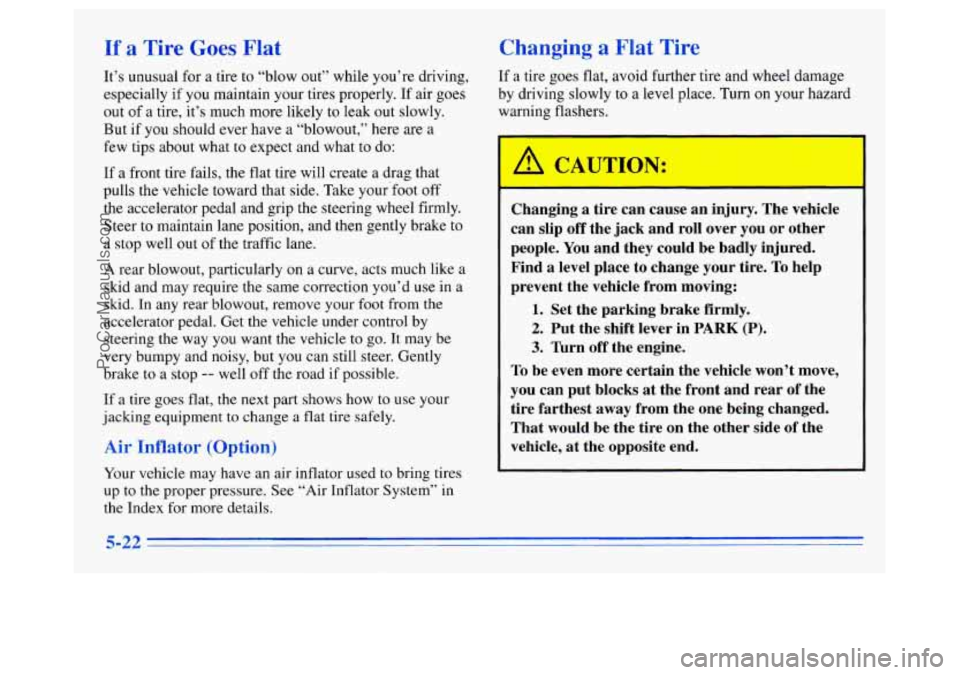Page 234 of 372

If a Tire Goes Flat
It’s unusual for a tire to “blow out” while you’re driving,
especially if you maintain your tires properly. If air goes
out of a tire, it’s much more likely to leak out slowly.
But if you should ever have a “blowout,” here are a
few tips about what to expect and what to do:
If a front tire fails, the flat tire will create a drag that
pulls the vehicle toward that side. Take your’foot off
the accelerator pedal and grip the steering wheel firmly.
Steer to maintain lane position, and then gently brake to
a stop well out of the traffic lane.
A rear blowout, particularly on a curve, acts much like a
skid and may require the same correction you’d use in a
skid. In any rear blowout, remove your foot from the
accelerator pedal. Get the vehicle under control by
steering the way you want the vehicle to
go. It may be
very bumpy and noisy, but you can still steer. Gently
brake
to a stop -- well off the road if possible.
If a tire goes flat, the next part shows how to use your
jacking equipment to change a flat tire safely.
Air Inflator (Option)
Your vehicle may have an air inflator used to bring tires
up
to the proper pressure. See “Air Inflator System” in
the Index for more details.
Changing a Flat Tire
If a tire goes flat, avoid further tire and wheel damage
by driving slowly to a level place. Turn on your hazard
warning flashers.
Changing a tire can cause an injury. The vehicle
can slip off the jack and roll over you
or other
people. You and they could be badly injured.
Find a level place to change your tire. To help
prevent the vehicle from moving:
1. Set the parking brake firmly.
2. Put the shift lever in PARK (P).
3. Turn off the engine.
To be even more certain the vehicle won’t move,
you can put blocks at the front and rear of the
tire farthest away from the one being changed.
That would be the tire on the other side of the
vehicle, at the opposite end.
5-22
ProCarManuals.com
Page 236 of 372
Remove the jack and jacking tools by loosening the
wing
nut and retainer bar.
Separate the plastic pouch from the jack and remove the
jacking
tools (folding wrench and shaft) from the pouch. The compact spare
tire is located under the vehicle,
behind the rear bumper. Insert the narrow end of the
shaft into the hole above the rear bumper. Then attach
the folding wrench to the shaft.
Rotate the folding wrench counterclockwise to lower the
compact spare tire until it can be pulled from under
the vehicle.
ProCarManuals.com
Page 244 of 372

Replace all jacking tools as they were stored in the
’ storage compartment and replace the compartment
cover. Be sure to also store the nylon nut caps.
When you replace the compact spare tire with a full-size
tire, replace the nylon nut caps over the wheel nuts.
Tighten them “hand tight” using the folding wrench.
Compact Spare Tire
Although the compact spare tire was fully inflated
when your vehicle was new, it can lose air after a time.
Check the inflation pressure regularly. It should be
60 psi (420 kPa).
After installing the compact spare on your vehicle, you
should stop as soon as possible and make sure your
spare tire is correctly inflated. The compact spare is
made to perform well at posted speed limits for
distances up to
3,000 miles (5 000 km), so you can
finish your trip and have your full-size tire repaired or
replaced where you want. Of course, it’s best to replace
your spare with a full-size tire as soon as you can. Your
spare will last longer and be in good shape in case you
need it again.
NOTICE:
When the compact spare is installed, don’t take
your vehicle through an automatic vehicle wash with guide rails. The compact spare can get
caught on the rails. That can damage the tire and
wheel, and maybe other parts
of your vehicle.
5-32
ProCarManuals.com